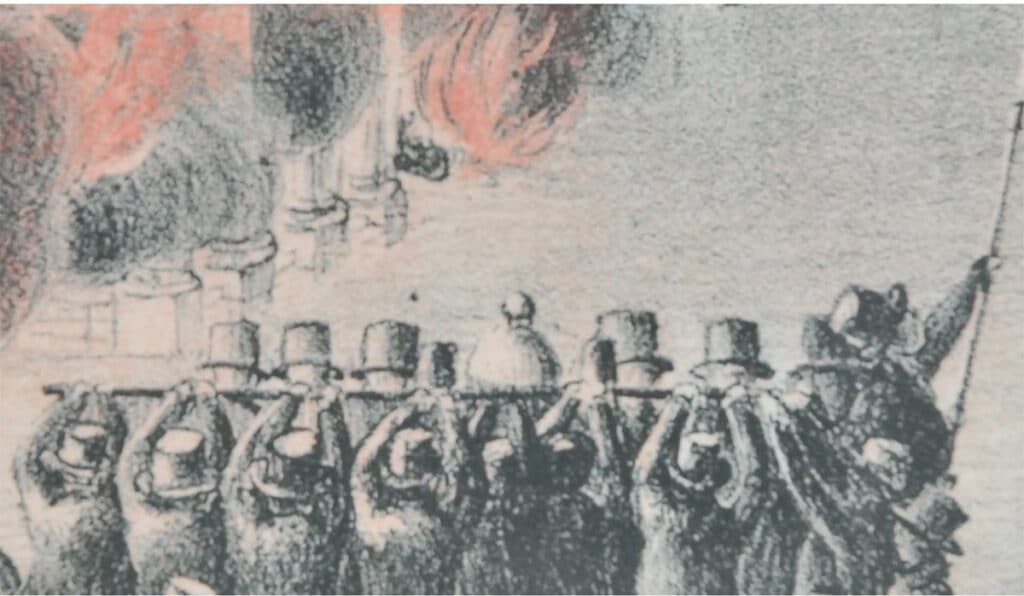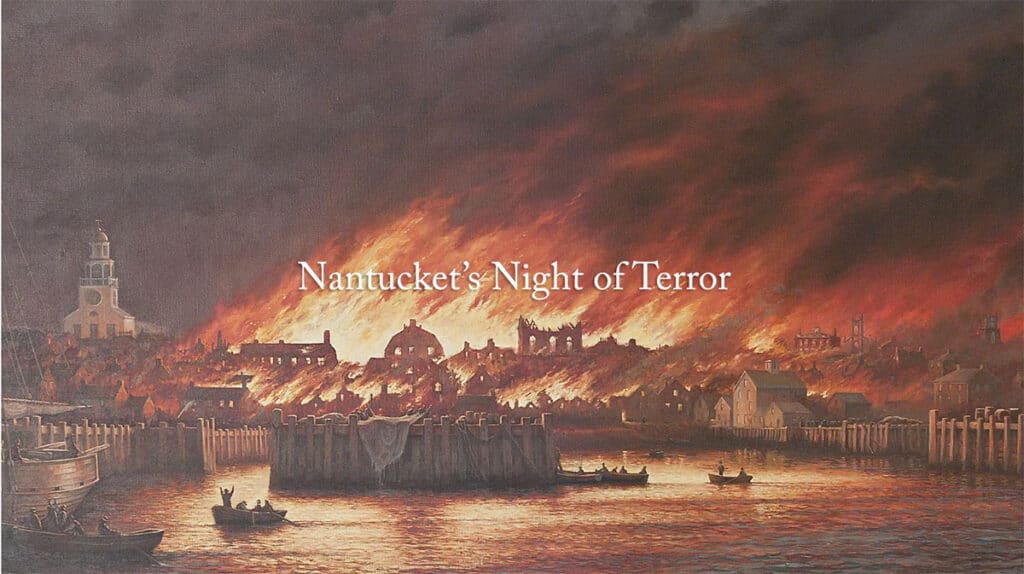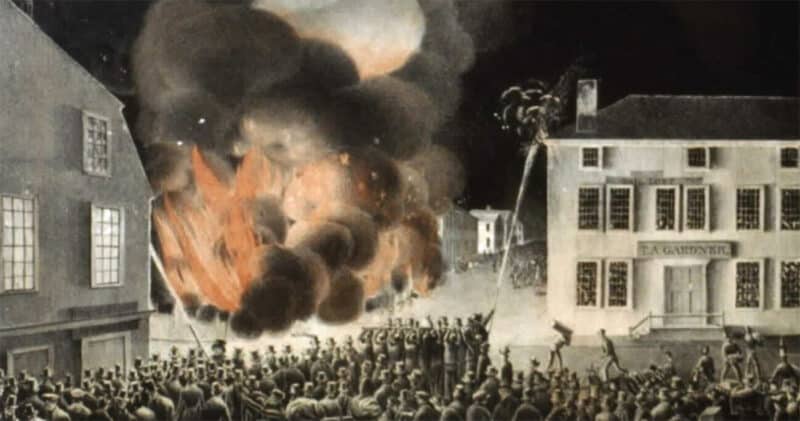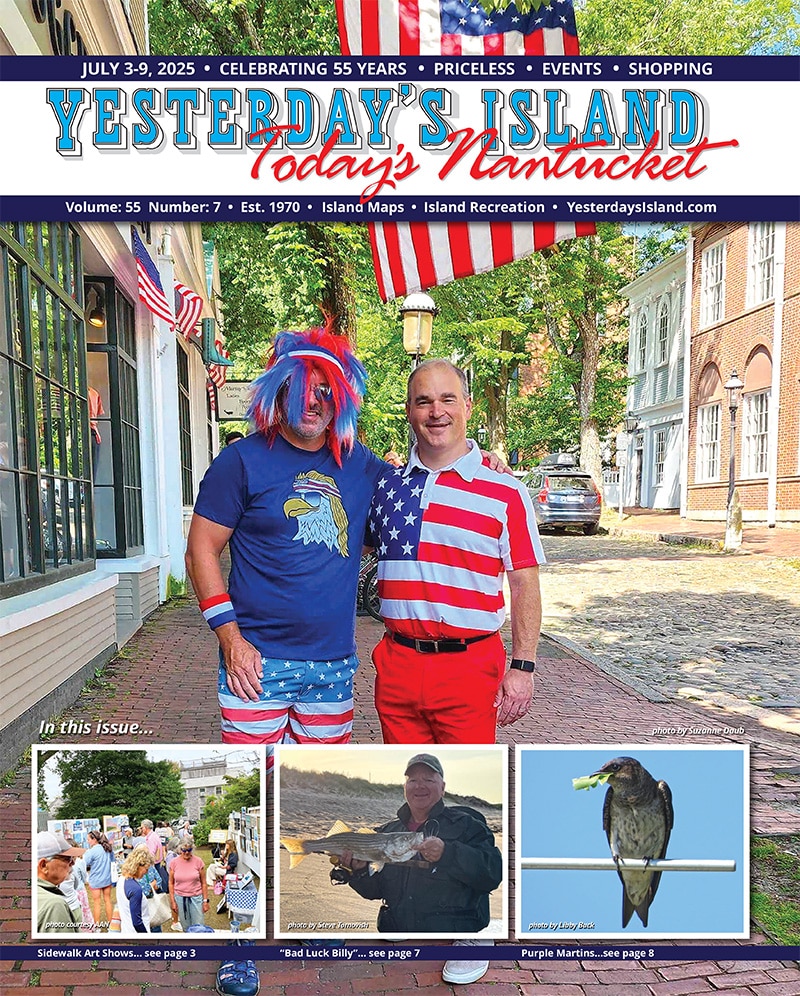Imagine standing on the steps of the Pacific National Bank of Nantucket at the top of Main Street early in the morning on July 14. You look toward the Harbor and see nothing before you but smoking ashes and the brickwork of the Pacific Club Building. To the left, the Jared Coffin House is a lonely sentinel amid the ruin; to the right stands the badly scorched facade of the shops at the corner of Main and Orange.
This week, 176 years ago, the Great Fire of 1846 consumed one-third of Nantucket Town. This was the worst disaster in terms of material destruction that had ever hit the island, and it came at a time when Nantucket was vulnerable.
In 1846, Nantucket appeared to be a prosperous and cosmopolitan town. Decades of success in the whaling industry had brought wealth and sophistication to this small island. Nearly 10,000 people called Nantucket home; mansions built with whaling profits lined upper Main Street; 3 newspapers were being published; and the center of town was a bustling commercial area. Between July of 1842 and July of 1845, more than 44,000 vessels passed through Nantucket Sound.
But the unbridled success of the previous decades had resulted in overfishing, and whaling men had to travel farther and stay out longer to fill their holds with oil. A sandbar across the mouth of Nantucket Harbor prevented the large, heavily- laden ships from entering, so many chose instead to depart from New Bedford’s deep port. The Great Fire of 1846 hastened the decline.
Fire had struck Nantucket several times before 1846: Brant Point Lighthouse had twice been destroyed by flames, the Fire of 1836 destroyed a hotel and several stores on Main Street, and, four years before the Great Fire, the Asylum at Quaise burned, killing 10 of its residents. The Town relied upon volunteer fire companies, hand-pumpers, and large underground cisterns of water for their defense.
The summer of 1846 was hot and very dry. When fire broke out around 11 pm on the night of July 13, two volunteer fire companies rushed to William H. Geary’s Hat Shop on the south side of Main Street. A fire had started in the shop’s stovepipe, and spread to the wall, and flames lit up the sky. Volunteers from two different fire companies rushed to the scene—Company of Cataract Engine No. 6 arrived first and connected to the underground water cistern on the lower square, only to find it was too far from the fire to be effective. Brigade Fountain No. 8 arrived from farther up Main Street and pleaded with Catarat brigade to connect the two companies hoses to lengthen them.
Cataract 6 refused: they wanted the honor of being the first to pour water on the fire. As they argued, the flames went through the roof and out of control.
By midnight the fire had spread to the largest structure in town, Washington Hall. The wooden structures of Main Street were quickly consumed as the blaze grew to frightening proportions, aided by the night winds. The fire’s course was swift and devastating. In an effort to stop the fire’s rapid progress, residents tried to create firebreaks by blowing up buildings with gunpowder. But nothing, it seemed, could stop the flames. The entire business district was ablaze. The air was filled with smoke, ash, heat, and the terrible sounds of bursting glass, crackling wood, and falling buildings.
Shops, offices, and storehouses were destroyed. The brick Rotch Warehouse (now the Pacific Club) at the base of Main Street was damaged but survived, as did the brick Town Building at 2 Union Street. The Atheneum was destroyed and the fire consumed every structure on Centre Street from Main to Broad streets.
The streets filled with desperate people. Some simply watched in horror, some tried to help combat the fire. Eyewitness William Macy later stated: “standing on the steps of the Pacific Bank and looking east and north on Centre Street, east side as far as the Ocean House [now Jared Coffin House], every building was at one time on fire save the old insurance office building [the Pacific Club] on the lower square.” The Methodist Church survived, due to the efforts of volunteers who performed a bucket brigade and spread wet carpets over the roof.
Jared Coffin’s brick home at Broad and Centre helped check the flames. The fire turned east, where there were highly combustible factory buildings. Helped to spread by its own currents and updraft, the fire headed for the waterfront. Wooden wharves, ropewalks, cooperages, and storage houses, all soaked with oil, and caked with pitch and grease fed the inferno. It reached the casks of oil stored there. As they burst with the heat, the oil spewed across the surface of the harbor and ignited ships docked there until even the water was burning.

By dawn the morning of July 14, 1846, the heart of Nantucket Town had been reduced to ashes. No one perished in the Great Fire, but many hundreds were left homeless and destitute. Between 400 and 500 buildings on 36 acres had been destroyed; by conservative estimates, $1,000,000 in damage had been sustained.
Knowing that they would need aid to survive this disaster, the townspeople through the Selectmen sent an appeal to cities and towns of New England:
“One-third of our town is in ashes. A fire broke out on Monday evening last… and raged almost uncontrolled, for about nine hours. The whole business section of the town is consumed. There is scarcely a dry goods, a grocery, or provision store left standing….There is not food enough in town to keep wide-spread suffering from hunger at bay a single week….Hundreds of families are without a roof to cover them, a bed to lie upon, and very many of them even without a change of raiment. Widows and old men have been stripped of their all; they have no hopes for the future, except such as are founded upon the humanity of others.
“We are in deep trouble….We need help–liberal and immediate. If we seem to you importunate, we can only say that could you look upon the yet smoking ruins of one third of our Town–could you walk through our remaining streets filled with houseless hundreds wandering about seeking for some roof to cover them, or for such remnants of their household goods as may have been snatched by others from the flames–could you feel, as we do, that not many days pass before positive want will be knocking at our doors–our words would appear feeble, our appeal certainly not more earnest than the occasion requires….”
Towns in America responded quickly with about $100,000 in assistance, and within a few months rebuilding began. Main Street was straightened and widened to prevent future fires from crossing it and some alleys and lanes were closed. Brick was used whenever possible—two blocks of brick buildings were built on the north side of Main. The Atheneum was rebuilt within a year. In 1847, Maria Mitchell sighted her comet from her rooftop observatory on the Pacific Bank.
To watch the Nantucket Historical Association’s video “Nantucket’s Night of Terror,” visit nha.org/whats-on/public-programs/the-great-fire-of-1846/

Last week, on July 9, a devastating fire in town destroyed the historic Veranda House and two neighboring homes. Community members including Peter Georgantas, Jim McIntosh, Frank Harris, Patrick Marks, Fire Captain Nathan Barber (off-duty at the time) helped victims, in some cases saving their lives. Members of the Nantucket Fire Department fought the blaze with assistance from Cape Cod firefighters, containing it to three structures when far more were at risk. Island residents and businesses rallied to offer help to those displaced by the fire.
The Nantucket Police Department issued this statement:
Yesterday was a loss for Nantucket, however we’d like to take this time to extend a huge THANK YOU.
First and foremost a huge thank you to the Nantucket Fire Department who without a doubt prevented a massive fire from spreading and causing even more of a loss. Thank you to the Cape Cod Fire Departments and beyond who also arrived and went straight to work. All firefighters and first responders worked selflessly and diligently together to knock down the fire and keep it contained.
Secondly, to the local businesses, restaurants, and private citizens who showed an outpouring support for the victims and first responders. Almost immediately was a coffee cart station set up with water, drinks and food. Multiple inns and hotels, along with private homes in the area soon began to open their doors to whatever the victims of the fire needed. To the local clothing and thrift stores who without hesitation began donating clothing along with other toiletry items. To the restaurants and private citizens who continuously dropped off water, Gatorades, sandwiches, ice and more to ensure everyone on scene working remained hydrated and nourished.
Thirdly, thank you to the hospital staff to include nurses and doctors who showed up on scene to ensure the safety or our fire fighters and first responders. They were there to help in anyway needed and were closely monitoring those working to make sure they remained safe.
It was truly incredible to see the selflessness and quick action of so many to help our community. Even when the area was surrounded by heavy smoke, you all still showed up to do what you could. It is in times like these that remind us of what a special community Nantucket truly is. So again, THANK YOU.



